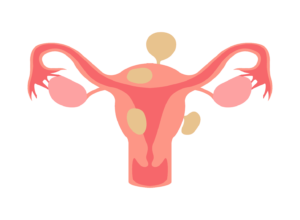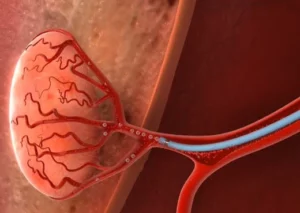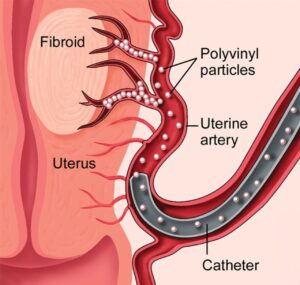Table of Contents
Uterine Fibroid Embolization
If you have uterine fibroids, you may be familiar with the symptoms they can cause, such as heavy menstrual bleeding, pelvic pain, pressure, and bloating. You may also be wondering what your treatment options are, especially if you want to avoid surgery or preserve your fertility.
One of the treatments that you may not have heard of is uterine fibroid embolization (UFE), also known as uterine artery embolization (UAE). UFE is a minimally invasive procedure that can shrink fibroids and relieve symptoms without removing the uterus or the fibroids.

In this blog post, we will explain what UFE is, how it works, what are the benefits and risks, and who is a good candidate for this procedure.
What is UFE and how does it work?
UFE is a procedure that blocks the blood supply to the fibroids, causing them to shrink and die. Fibroids are benign (non-cancerous) tumors that grow in the wall of the uterus. They depend on a steady blood supply to grow and survive.

UFE is performed by an interventional radiologist, a doctor who specializes in using imaging techniques to guide minimally invasive procedures. UFE does not require general anesthesia or surgery. It can be done as an outpatient procedure or with a short hospital stay.
During UFE, the interventional radiologist makes a small incision in the groin or wrist and inserts a thin tube called a catheter into an artery. The catheter is guided to the arteries that supply blood to the uterus and the fibroids. Then, tiny particles made of plastic or gel are injected through the catheter into the arteries. These particles block the blood flow to the fibroids, causing them to shrink and die.
The procedure usually takes about an hour to complete. After UFE, you may experience some cramping, pain, nausea, fever, or vaginal discharge for a few days. These symptoms can be managed with medication and usually resolve within a week. You may also notice that your periods become lighter and less painful over time.
What are the benefits of UFE?

UFE has several benefits compared to other treatments for fibroids, such as surgery or medication. Some of these benefits are:
- UFE preserves the uterus and does not affect the ovaries or hormones.
- UFE does not require general anesthesia or surgery.
- UFE has a shorter recovery time and fewer complications than surgery.
- UFE can treat multiple fibroids at once and prevent them from growing back.
- UFE can improve symptoms such as heavy bleeding, pelvic pain, pressure, and bloating.
- UFE can improve quality of life and sexual function.
What are the risks of UFE?
UFE is generally safe and effective, but like any procedure, it has some potential risks and complications. Some of these risks are:
- Infection or bleeding at the incision site
- Damage to the artery or other organs
- Allergic reaction to the contrast dye or particles
- Inflammation or infection of the uterus or pelvis
- Early menopause or ovarian failure
- Loss of fertility or pregnancy complications
- Failure to shrink fibroids or relieve symptoms
Most of these risks are rare and can be treated with medication or surgery if they occur. However, some risks may be permanent or irreversible. Therefore, it is important to discuss the benefits and risks of UFE with your doctor before deciding on this procedure.
Who is a good candidate for UFE?
UFE may be a good option for you if you have symptomatic fibroids that interfere with your daily life and you want to avoid surgery or preserve your fertility. However, UFE may not be suitable for everyone. Some factors that may make you ineligible for UFE are:
- You have an active infection or inflammation in your pelvis
- You have an allergy to contrast dye or particles
- You have severe kidney disease or poor kidney function
- You have large or pedunculated (stalk-like) fibroids
- You have adenomyosis (a condition where the endometrium grows into the muscle layer of the uterus)
- You are pregnant or planning to get pregnant soon
To determine if you are a good candidate for UFE, you will need to undergo a thorough evaluation by your doctor and an interventional radiologist. This may include a physical exam, blood tests, imaging tests, and a consultation. You will also need to discuss your medical history, symptoms, goals, and expectations with your doctor and the interventional radiologist.
Nursing Responsibilities
Nursing responsibilities in UFE are the tasks and duties that nurses perform before, during, and after the procedure to ensure the safety and comfort of the patients. Some of the nursing responsibilities in UFE are:
- Assessing the patient’s medical history, symptoms, allergies, and medications
- Explaining the procedure, benefits, risks, and alternatives to the patient and obtaining informed consent
- Preparing the patient for the procedure by checking vital signs, inserting an intravenous line, and administering sedation and pain medication
- Assisting the interventional radiologist during the procedure by providing instruments, monitoring vital signs, and observing for complications
- Providing post-procedure care by applying pressure dressing, checking for bleeding or infection, managing pain and nausea, and educating the patient on discharge instructions
- Following up with the patient after discharge by calling or visiting to assess recovery, wound healing, and symptom relief
Nursing responsibilities in UFE require a high level of skill, knowledge, and professionalism. Nurses who work in UFE should have excellent communication, critical thinking, and problem-solving skills. They should also be familiar with the anatomy and physiology of the uterus and fibroids, the indications and contraindications for UFE, the types of particles and catheters used in UFE, and the potential complications and outcomes of UFE. Nurses who work in UFE should also be able to work well with a multidisciplinary team of doctors, technicians, and other nurses.
If you are interested in UFE, talk to your doctor about this option and ask for a referral to an interventional radiologist. UFE may be the solution you are looking for to treat your fibroids and improve your quality of life.
I hope this blog post was informative and helpful. Do you have any questions or feedback?
References
(1) Uterine Fibroid Embolization | NEJM.
(2) Uterine Fibroid Embolization | Johns Hopkins Interventional Radiology.
(3) Understanding Uterine Fibroid Embolization and Its Side Effects.
(4) Uterine Fibroid Embolization – University of Miami Health System.
(5) Uterine Fibroid Embolization (UFE) | Penn Medicine.
FAQs
Q: What is UFE?
A: UFE is a minimally invasive procedure that blocks the blood supply to fibroids, causing them to shrink and die.
Q: Who can have UFE?
A: UFE may be an option if you have symptomatic fibroids and want to avoid surgery or preserve fertility. Evaluation by your doctor and an interventional radiologist is necessary to determine if you are a good candidate.
Q: How is UFE performed?
A: A small incision is made in the groin or wrist, and a catheter is inserted into an artery. Tiny particles are injected through the catheter to block blood flow to the fibroids, causing them to shrink and die.
Q: What are the benefits of UFE?
A: Benefits include preserving the uterus, no need for surgery or general anesthesia, shorter recovery time, treating multiple fibroids, improving symptoms, and enhancing the quality of life.
Q: What are the risks of UFE?
A: Risks include infection, bleeding, damage to organs, allergic reactions, inflammation, menopause or ovarian failure, fertility issues, and treatment failure. Discuss risks with your doctor.
Q: How long does it take to recover from UFE?
A: Recovery time varies, but most patients can go home on the same or the next day. Cramping, pain, nausea, and discharge may occur but resolve within a week. Avoid strenuous activities, intercourse, and tampons for two weeks. Follow up with your doctors regularly.
Latest Posts
- NVS Staff Nurse Vacancy 2024 – How to Apply
- AIIMS NORCET 6 and ESIC Nursing Exam Questions and Answers
- ESIC Nursing Officer Recruitment 2024 | 1930 Vacancies – Apply Now
- Dream Job Alert: AIIMS NORCET Nursing Officer Vacancy 2024 – Apply Now!
- NIMHANS Nursing Officer Exam 17-12-2023 Memory-Based Solved Questions